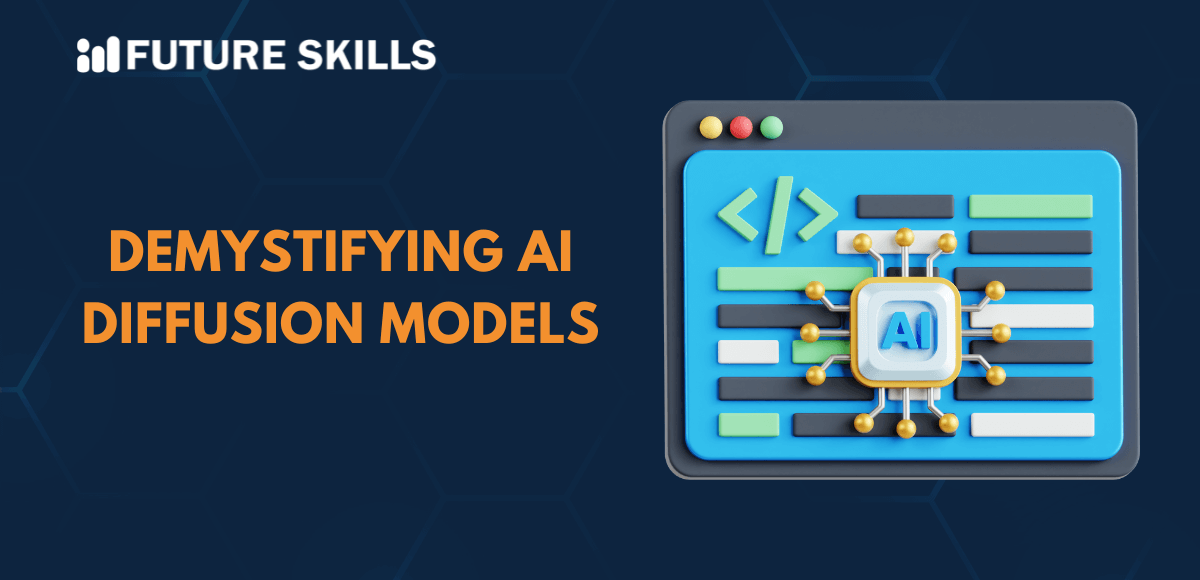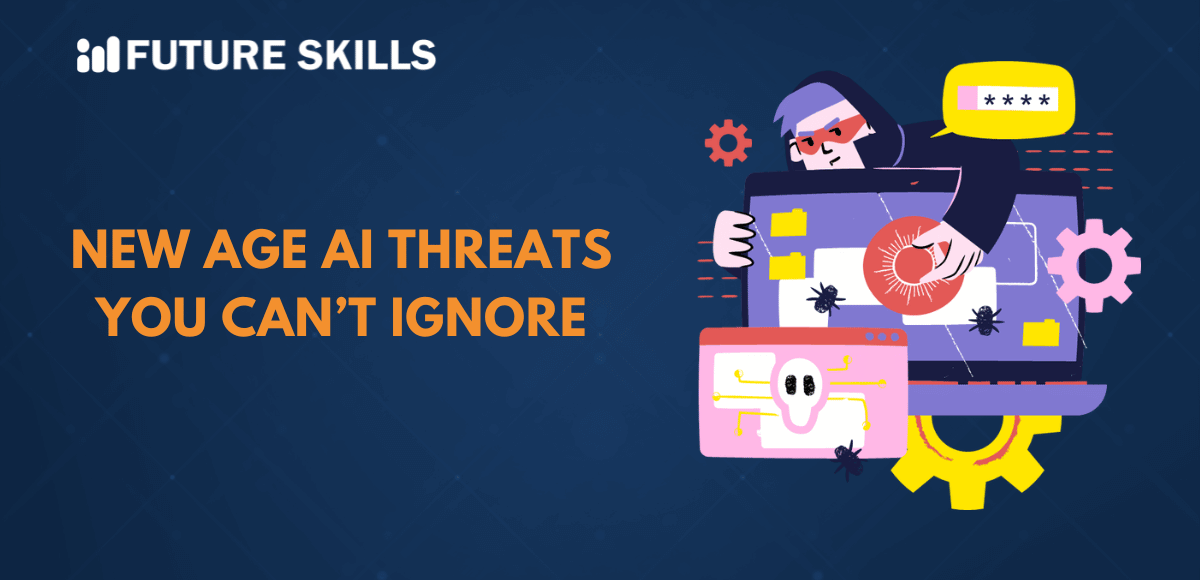You’ve probably scrolled past mind-boggling AI art, motion-capture avatars, or even whole mini-movies that sprang to life from just a few words. Odds are good those jaw-dropping visuals came from a diffusion model without you even knowing the name. If that last thought made you curious, now is a pretty good moment to ask, What is a diffusion model in AI?
This trick isn’t just another lab experiment; it feels almost like magic. Diffusion models have jumped into the spotlight because they’re stable, scalable, and they produce images or sounds that stand up to close inspection. In gaming, training simulations, and ad design, creative teams are already leaning on them the way filmmakers once reached for green screens.
Level up your AI skills and embark on a journey to build a successful career in AI with our Certified AI Professional (CAIP)™ program.
What Is a Diffusion Model in AI?
So what is a diffusion model in AI? Consider a photograph that has been coated in snowflakes and static. The system learns to scrub away the fuzz until a crisp image appears, and then, when you hit generate, it works that routine in reverse, flipping blank noise back into a usable picture.
Picture spreading a thin layer of color across a picture until it vanishes completely; that messy blur is what a diffusion model first explores. During training, the program studies that slow fogging-out process, step by random step, until it knows noise the way you know your hometown streets. Later, in real time, it flips the job, pulling detail back from static the way a photographer might rescue a sun-bleached slide. Because the stack of neural maps kept notes all through the mess, the newly minted result can look startlingly fresh and surprisingly original.
So, if someone asks you, What is a diffusion model in AI? shrug, smile, and say a smart bit of code that cleverly un-does noise. Each tiny adjustment it makes is wrapped in probability and bolstered by heaps of past photos or sound samples.
How Diffusion Models Power Generative AI
That answer, of course, falls squarely within the purview of diffusion models of generative AI. Countless artists, designers, and plain old dreamers now lean on these architectures whenever they type a wild prompt and hit Go. Early systems sometimes spat out blurry faces or warped hands, but diffusing magic tends to beat the errors flat. No wonder names like DALL-E 2, Midjourney, Imagen, and Stable Diffusion hog the headlines. They crank out postcard-ready scenes that feel like they were snapped that morning, all because you dared to describe what you see in your head.
Diffusion models have quickly become the talk of the generative-AI world, and for a good reason. Unlike older techniques, these models build images step by careful step, so there’s plenty of room to fix mistakes and sharpen the look. That built-in patience gives designers and engineers more control, which is exactly why fields as varied as advertising, gaming, and medical research are already leaning on them.
Enroll now in the Mastering Generative AI with LLMs Course to understand how language models work and their capabilities to solve real-world problems.
Diffusion Models Examples in the Real World
To truly understand the power of diffusion models examples, we need to look at how they’re used in practice. Here are just a few applications that highlight their versatility:
- Real-World Diffusion Projects: To see their muscles in action, you have to look at real people doing real work. Here’s a quick tour of diffusion models in the wild:
- Digital Art: With tools like Midjourney or Stable Diffusion, an illustrator can spin up an entire series of fantasy landscapes in under a minute. The ability to tweak styles on the fly turns concept sessions into high-speed brainstorming.
- Product Prototyping: Industrial teams now feed rough sketches into an AI that spits out a dozen usable mock-ups by lunch. Instant feedback means designers can worry less about drawing and more about what will actually sell.
- Medical Imaging: Engineers are training these networks on messy X-rays and MRIs to clean up artifacts and flag early signs of disease. Clinicians love them because quieter noise can make the difference between a routine scan and a life-changing diagnosis.
- Fashion Visualization: Brands plug the same technology into online fitting rooms, letting shoppers see a dress on a size-28 avatar before clicking buy. That kind of realism cuts returns and gives customers a sense of ownership long before they ever touch a stitch.
- Video Game Asset Generation: Game devs are finding fresh shortcuts, mainly thanks to diffusion models. These algorithms spit out quick background textures, mood-setting environmental art, and endless character skins, letting time-crunched 3D artists focus on polishing the shots that really matter.
Exploring Multi-Modal Capabilities of Diffusion Models GenAI
The buzz around diffusion models keeps growing, and for good reason. What once felt like a lab experiment has wiggle-room across photography, illustration, motion graphics, and now video games. Lately, the phrase diffusion models genAI keeps popping up. It bundles the classic image pipeline with a wider toolkit that acts on audio, video, and even 3D meshes you can rotate.
Take Google: their Imagen Video engine taps the same diffusion math to turn plain text into jitter-free, scene-to-scene clips. OpenAI isn’t sitting still, either; its new waveform work cooks up speech, tunes, or any in-between audio snap with surprising warmth.
Put all that together and one model now talks in pixels, waves, letters, and moving frames. Picture asking an AI for a rainy street corner, then watching clouds materialize, hearing distant thunder, and feeling the pavement texture in stereo as it all loads around you.
Level up your ChatGPT skills and kickstart your journey towards superhuman capabilities with Free ChatGPT and AI Fundamental Course.
Challenges and Limitations Still Ahead
Diffusion models sound cool, but they don’t come easy. Training one from scratch gobbles up weeks of GPU time and swallows a mountain of image data. Most hobbyists and even some small labs just can t afford that kind of bill.
The ethics are messy, too. Because the software can copy almost any style-or flat-out forge a video-it blurs the lines between original art, stolen art, and outright fake news. Copyright owners and everyday viewers are both left scratching their heads over what can be believed and who should get paid.
Not everyone can play with the big toys yet. Platforms like Hugging Face and Runway have released lighter versions that run in a browser, but the full horsepower still lives in corporate datacenters and elite university labs. Opening those gates without losing control will be one of the thorniest problems of the next few years.
Why It Matters for Your AI Skill Set
You don’t have to be a code wizard to see why this matters. Students, marketers, vloggers-everyone in the creative space should at least know how diffusion works. Odds are good that the next round of commercial software you are asked to master will pack AI diffusion models under the hood. Getting ahead of that curve could save you a lot of time later on.
Learning how to steer, prompt, or even fine-tune a diffusion system can suddenly open the door to jobs you never knew existed. Roles like AI product designer and prompt engineer are popping up everywhere, and companies are eager to hire folks who really get these models.
Explore the implications of supervised, unsupervised, and reinforcement learning in diverse real-world use cases with Machine Learning Essentials Course
Conclusion
So, to answer the initial question—What is a diffusion model in AI?—it’s not just a method. It’s way more than another algorithm on a research slide. These systems let computers dream, polish, and finally spit out images, text, or sound that look almost human-made.
Today, the buzz has moved from labs to boardrooms. Whether you’re glancing at a fresh diffusion models generative AI research paper, tinkering with diffusion models examples, or sketching your own app, that knowledge puts you ahead of the curve in a field that rewrites its own rulebook every month. To keep your skills sharp and ride the next wave of generative intelligence, dive into the hands-on guides and deep dives sitting in the blog vault at Future Skills Academy.






